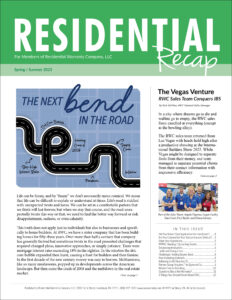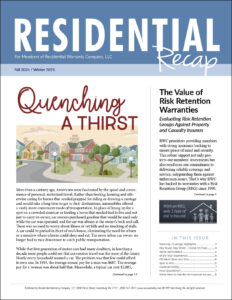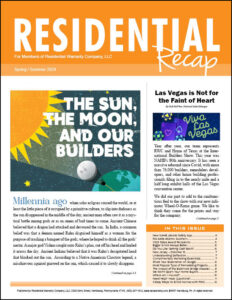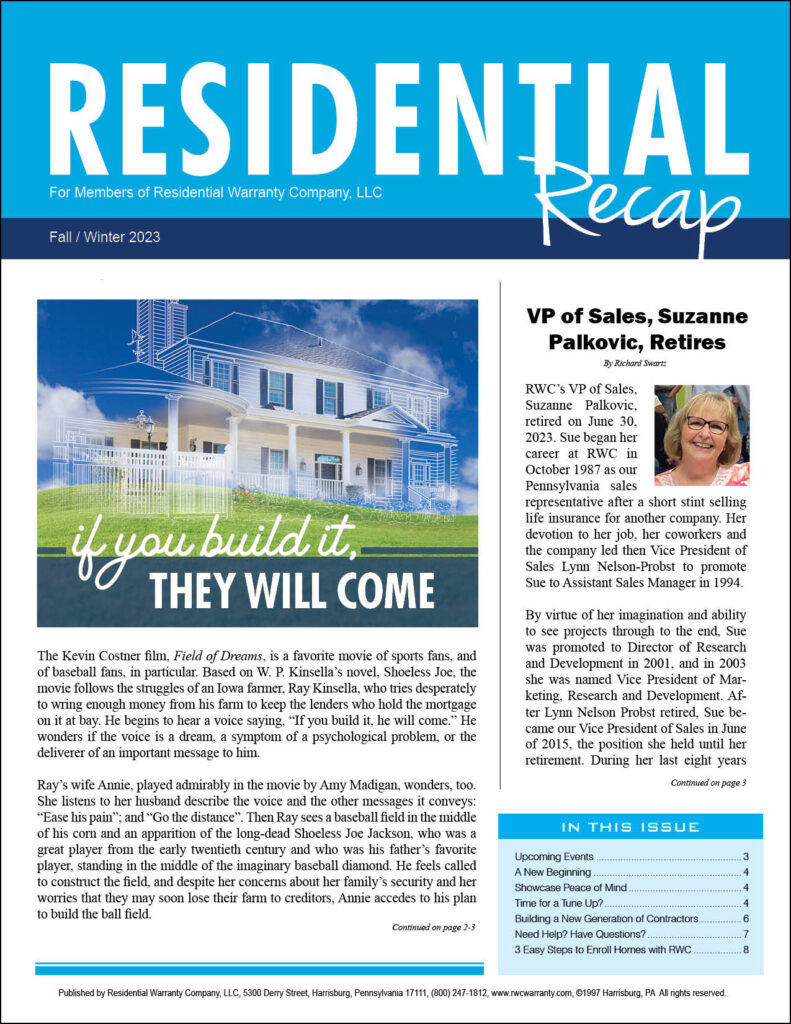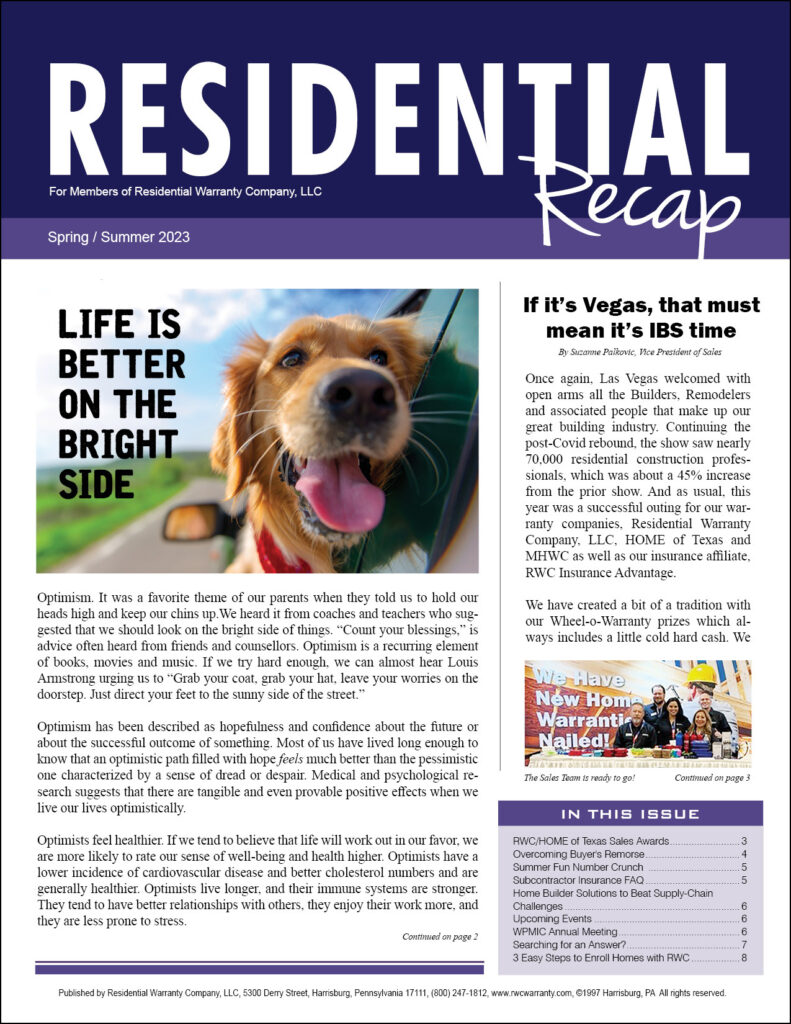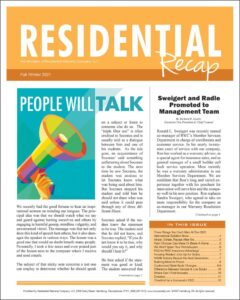Check out building/warranty/industry news, RWC announcements, upcoming events, etc.
Check out building/warranty/industry news, RWC announcements, upcoming events, etc.
Check out building/warranty/industry news, RWC announcements, upcoming events, etc.
Check out building / warranty / industry news, RWC announcements, upcoming events, etc.
 After decades of dedicated service and unwavering commitment, VP of Sales, Suzanne Palkovic, bid farewell to RWC & Affiliates this summer as she embarks on a well-deserved retirement.
After decades of dedicated service and unwavering commitment, VP of Sales, Suzanne Palkovic, bid farewell to RWC & Affiliates this summer as she embarks on a well-deserved retirement.
Sue began her career at RWC in October 1987 as our Pennsylvania sales representative after a short stint selling life insurance for another company. Her devotion to her job, her coworkers and the company led then Vice President of Sales Lynn Nelson-Probst to promote Sue to Assistant Sales Manager in 1994.
By virtue of her imagination and ability to see projects through to the end, Sue was promoted to Director of Research and Development in 2001, and in 2003 she was named Vice President of Marketing, Research and Development. After Lynn Nelson Probst retired, Sue became our Vice President of Sales in June of 2015, the position she held until her retirement. During her last eight years with the company, she managed our entire sales force and was a constant proponent of superior customer service for our builder members. Sue was a tireless worker for our company. Her strong leadership and keen understanding of the warranty marketplace contributed greatly to our companies’ success. We will miss her wit, her wisdom, her tenacity, and her dedication.
Sue is succeeded by our new National Sales Manager, Rich McPhee. Rich is new to the position, but not to the company, having served as a highly successful sales representative in the mid-Atlantic states for the last ten years. Sue had an opportunity to mentor Rich, and we are happy to report that he has hit the ground running.
Sue plans to travel, spend time with her family, and become more active supporting causes that are near and dear to her heart. She leaves RWC with our good wishes for a long, happy and healthy retirement and with heartfelt gratitude for many years of loyal service.
Check out building / warranty / industry news, RWC announcements, upcoming events, etc.
You’re a general contractor, a GC. Like it or not, you are responsible for everyone’s safety at your jobsites. That means anyone who may be there for any reason. Even trespassers who trip and fall over some debris left by your demo guy. That’s right. Even if you post “NO TRESPASSING” signs, you have some degree of care for any member of the public who is at your job site for any reason and gets hurt. What can I say? Life isn’t fair, then you get sued.
Any human activity involves risk. To really prevent having accidents at your jobsite you’d have to go back in time to that day when you decided to become a GC and decide to do something else. Until a time machine is invented, you’ll need General Liability (GL) insurance and you’ll want all your subcontractors to be adequately insured.
Why is GL insurance so important?
Let’s go back to the sloppy demo contractor who left the debris lying around for the trespasser to trip over.
If that demo guy doesn’t have insurance, your GL company will not only have to pay this claim; they will add the demo classification to your policy and charge you the extra premium. It’s hard enough to be sure your subs have enough insurance even when you require certificates each year.
For example, if one of your subs has a claim working for someone else and it reduces his/her limit of liability, that certificate you got a few months ago is suddenly out of date.
It says your subcontractor has $1,000,000 for each accident. Only now, the claim has reduced this amount to $500,000. Suppose one of your subcontractors had their GL coverage canceled or nonrenewed? If you’re listed as an additional insured on their policy you should receive a courtesy notice of cancellation… provided you asked for one and insisted it be shown on the certificate.
Either one of these possible scenarios can lead to a claim being made against your GL.
But what about that trespasser? Why should he be compensated for getting hurt while being illegally present on your jobsite? The answer has to do with the degree of responsibility you have to the public. Think of your own home as a jobsite. Let’s say you invite friends over to a Memorial Day picnic. You want them to be there. The last thing you want is for one of them to trip and fall over your garden hose laying in the yard because you failed to put it away.
The same is true for the delivery person and the guy who reads your gas meter. Then there’s the door-to-door salesperson or survey taker. You’re not as happy to see them, but you wouldn’t call 911 when they show up either. The one thing all these people have in common is a right to expect that you keep your yard, sidewalk and steps free of objects like your garden hose, stray toys and other debris when they come calling.
Even a burglar or a vandal is owed some degree of care. You can’t use excessive force to restrain a burglar and you can’t take the position that a trespasser should just watch their step if there is an unprotected hazard on your jobsite.
Failing to understand these things and take steps to minimize the hazards at your jobsite creates liability. Your subcontractors are your first line of defense against lawsuits.
Here are four things you can do to make sure your subcontractors are helping to reduce your chance of being sued:
• TRIP AND FALL HAZARDS that can’t be eliminated must be marked with signs, cones, reflective tape, etc., in such a way that they are obvious to the public.
• Require your subs to provide CERTIFICATES OF INSURANCE each year. These should show your subcontractors have their own GL coverage with limits of liability equal to yours.
• Insist that they name you as ADDITIONAL INSURED on their policies.
• Make sure they HOLD YOU HARMLESS in your contracts with them.
Never let up on your efforts to hold your subs to this high standard and to practice good jobsite preventive maintenance.
by Doug Davis, Eastern Atlantic Insurance Company
Click below to read about industry news, announcements, upcoming events, etc.
Stay up-to-date with the Warranty Company, Upcoming Events, & Industry News.
A home is one of the biggest investments a person will ever make and in order to keep that home glowing and increasing in value, a well-maintained property should be the goal for years to come. Of course, a warranty will provide protection, but seasonal maintenance by the homeowner is also key to long-lasting digs. As a professional in the industry, you’ve seen first-hand what irresponsibility will do to a residence. It’s imperative to remind your buyers that even though a home may be brand spanking new, regular maintenance is absolutely necessary to ensure safety, comfort, and retain resale value.
It’s easy to preach to a homebuyer about keeping up with seasonal tasks and send them on their merry way, but why not arm them with a comprehensive list of things they should be aware of? Steer them toward RWC's "season maintenance checklist" under the Homeowner's tab. This is a great tool for homeowners to stay on top of things. Furthermore, you as the builder must have gathered hundreds of maintenance tips during your career. Offer up those tips and hints as you meet with your clients throughout the home building journey.
Just for fun, here is a home maintenance quiz that will test your know-how. While this quiz does not address every conventional home maintenance project, it does provide helpful tips that may have been overlooked.
1. How often do forced-air furnace filters need to be changed?
At least every three months during the heating season.
2. What part of the faucet usually needs to be replaced when you have a water leak?
The washer.
3. Should you run hot or cold water through your garbage disposal?
Cold water.
4. How often should the moving parts of garage doors be oiled?
Every three months.
5. What tools can you use to unclog your drains?
A plunger and a plumber’s snake.
6. What tool can be used to unclog a toilet?
Coil spring-steel auger.
7. What faucet part needs to be cleaned every three to four months?
Aerator — the screen inside the end of the faucet.
8. What can you use for traction on icy sidewalks, steps, and driveways?
Cat litter or sand — never use salt because it damages the pavement.
9. Where should the fire in your fireplace be built?
On the irons or grate, never on the fireplace floor.
10. What will prevent soot and add color to the fire in your fireplace?
Throw in a handful of salt.
11. Where should your firewood be stored?
Outside, away from your house and not directly on the ground.
12. What helps keep unpainted concrete floors easy to keep clean?
Concrete Sealer.
13. What should you use to clean unpainted concrete floors?
A solution of 4 to 6 tablespoons of washing soda in a gallon of hot water. Mix scouring powder to the solution for tough jobs.
14. Why should frozen pipes be thawed slowly?
Frozen pipes should be thawed slowly to prevent the formation of steam, which could cause the pipe to burst.
15. How often should your roof be inspected?
A qualified roofer should inspect your roof every three years.
16. What should be regularly checked on your security system?
The alarms and circuit breakers should be checked to make sure they are in working order and the sensors should be inspected one by one.
17. At what temperature should your water heater be set?
120 degrees Fahrenheit
18. How often do skylights need to be inspected?
Skylights should be inspected each time your roof is inspected so leaks don’t develop from cracks and interruptions around its seals, caulking and flashings.
19. What can you use to help a window slide easily?
Rub the channel with a piece of paraffin.
20. What should you look for when you inspect your siding yearly?
Determine if wood-sided homes need to be repainted; check to see if the caulking around the windows and doors has split and cracked, and replace the caulk; clean the mildew; trim shrubbery away so it does not touch the siding.
(Quiz provided by NAHB.org)

